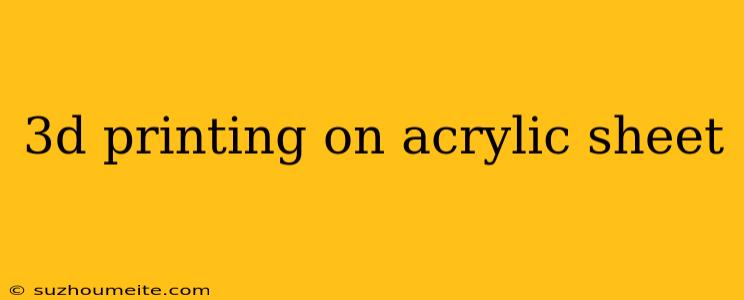3D Printing on Acrylic Sheet: A Comprehensive Guide
Introduction
3D printing on acrylic sheets has become increasingly popular among makers, DIY enthusiasts, and industries alike. The process involves printing 3D objects directly onto an acrylic sheet, offering a unique combination of durability, transparency, and design flexibility. In this article, we will delve into the world of 3D printing on acrylic sheets, exploring the benefits, materials, and techniques involved.
Benefits of 3D Printing on Acrylic Sheets
Durability and Strength
Acrylic sheets provide an added layer of protection to the 3D printed object, making it more resistant to scratches, cracks, and breakage.
Transparency and Aesthetics
The transparent nature of acrylic sheets allows for the creation of unique, visually appealing designs that showcase the internal structure of the 3D printed object.
Easy Post-Processing
Acrylic sheets can be easily cut, drilled, and polished, making post-processing a breeze.
Wide Range of Applications
From prototyping to production, 3D printing on acrylic sheets is suitable for various industries, including architecture, product design, and biomedicine.
Materials and Equipment
- Acrylic Sheets: Available in various thicknesses (1-10 mm), acrylic sheets can be sourced from most hardware stores or online retailers.
- 3D Printer: Any FFF/FDM 3D printer capable of printing with PLA or ABS filament can be used.
- Adhesives: A suitable adhesive, such as cyanoacrylate or epoxy, is required to bond the 3D printed object to the acrylic sheet.
Techniques and Tips
Surface Preparation
Ensure the acrylic sheet is clean and free of dust and oils. Apply a thin layer of adhesive to the printing surface.
Printing Parameters
Adjust printing settings to compensate for the smooth surface of the acrylic sheet:
- Layer Height: 0.1-0.3 mm
- Infill Density: 10-20%
- Support Material: None or minimal
Adhesion and Bonding
Apply even pressure to ensure a strong bond between the 3D printed object and the acrylic sheet.
Post-Processing
Cut, drill, and polish the acrylic sheet as needed to achieve the desired finish.
Conclusion
3D printing on acrylic sheets offers a unique combination of strength, aesthetics, and design flexibility. By understanding the benefits, materials, and techniques involved, makers and industries alike can unlock the full potential of this innovative technology. Get creative and start printing!
